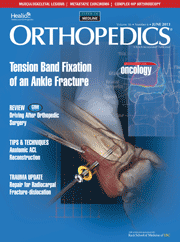
SHOULDER & ELBOW
Double-row repair significantly reduced recurrence, especially in partial-thickness tears
This report has been verified
by one or more authors of the
original publication.
Orthopedics. 2014 Nov 1;37(11):e1006-13
Six randomized controlled trials comparing single- and double-row rotator cuff repairs were included in this meta-analysis. The primary outcome of interest was recurrence and the secondary outcomes were functional scores: American Shoulder and Elbow Surgeons shoulder score, the Constant shoulder score, and the University of California, Los Angeles score. Pooled findings suggested significantly decreased incidence of recurrence with the double-row technique, particularly in partial-thickness re-tears. No differences between groups were observed for any of the functional outcome measures of interest.
Unlock the full ACE Report
You have access to {0} free articles per month.Click below to unlock and view this {1}
Unlock NowCritical appraisals of the latest, high-impact randomized controlled trials and systematic reviews in orthopaedics
Access to OrthoEvidence podcast content, including collaborations with the Journal of Bone and Joint Surgery, interviews with internationally recognized surgeons, and roundtable discussions on orthopaedic news and topics
Subscription to The Pulse, a twice-weekly evidence-based newsletter designed to help you make better clinical decisions
Exclusive access to original content articles, including in-house systematic reviews, and articles on health research methods and hot orthopaedic topics
Or upgrade today and gain access to all OrthoEvidence content for just $1.99 per week.
Already have an account? Log in


Subscribe to "The Pulse"
Evidence-Based Orthopaedics direct to your inbox.
{0} of {1} free articles
Become an OrthoEvidence Premium Member. Expand your perspective with high-quality evidence.
Upgrade Now













































































